Its Ok if All You Did Today Was Survive Art
So you lot're stranded in the wilderness. You consumed the last nub of your Clif Bar two days ago, and at present you're feeling famished. Civilization is nonetheless several days away, and you need to keep up your strength. The greenery all effectually you is looking more and more appetizing. But what to crumb on? Some plants will keep you live and are chock full of essential vitamins and minerals, while some could make you violently ill….or even impale you.
Which of form makes proper identification absolutely critical.
Below we've given a primer on 19 mutual edible wild plants. Look them over and commit the plants to retentiveness. If you lot'd like to discover even more edible wild plants, we propose checking out the SAS Survival Handbook and the U.S. Regular army Survival Transmission.
In the coming months, we'll be publishing articles on edible wild roots, berries, and fungi. Then stay tuned.
Plants to Avert
If you can't conspicuously identify a plant and you don't know if it'due south poisonous, it'south ameliorate to be condom than sad. Steer clear from a plant if it has:
- Milky or discolored sap
- Spines, fine hairs, or thorns
- Beans, bulbs, or seeds inside pods
- Bitter or soapy sense of taste
- Dill, carrot, parsnip, or parsley-like foliage
- "Almond" scent in the woody parts and leaves
- Grain heads with pink, purplish, or black spurs
- Iii-leaved growth design
Many toxic plants volition exhibit one or more of the above characteristics. Carry in listen that some of the plants we propose below have some of these attributes, even so they're still edible. The characteristics listed are only guidelines for when you're non confident about what you lot're dealing with. If yous want to be completely sure that an unknown plant is edible, and you lot have a 24-hour interval or two to spare, y'all tin e'er perform the Universal Edibility Test.
Amaranth (Amaranthus retroflexus and other species)
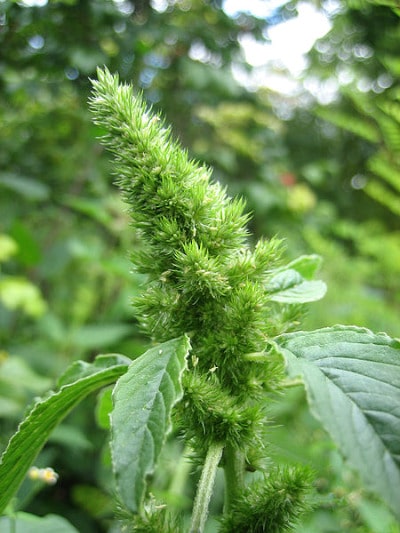
Native to the Americas but institute on about continents, amaranth is an edible weed. You tin can eat all parts of the plant, just be on the look out for spines that appear on some of the leaves. While not poisonous, amaranth leaves do comprise oxalic acrid and may contain large amounts of nitrates if grown in nitrate-rich soil. It'southward recommended that you boil the leaves to remove the oxalic acid and nitrates. Don't drink the water later on you boil the plant. With that said, you tin swallow the plant raw if worse comes to worst.
Asparagus(Asparagus officinalis)
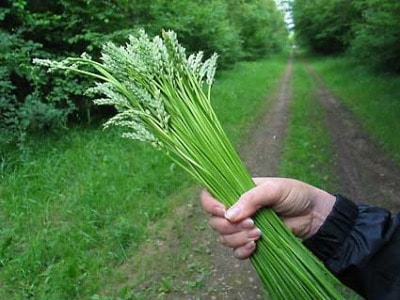
The vegetable that makes your pee olfactory property funny grows in the wild in nigh of Europe and parts of Northward Africa, Westward Asia, and Northward America. Wild asparagus has a much thinner stalk than the grocery-store diverseness. It'southward a great source of source of vitamin C, thiamine, potassium, and vitamin B6. Eat it raw or boil it similar you would your asparagus at habitation.
Burdock(Arctium lappa)

Medium to large-sized institute with big leaves and purplish thistle-like flower heads. The plant is native to the temperate areas of the Eastern Hemisphere; however, it has been naturalized in parts of the Western Hemisphere besides. Burdock is really a popular food in Japan. You tin eat the leaves and the peeled stalks of the found either raw or boiled. The leaves have a biting sense of taste, and so boiling them twice before eating is recommended to remove the bitterness. The root of the establish can besides be peeled, boiled, and eaten.
Cattail (Typha)

Known as cattails or punks in Due north America and bullrush and reedmace in England, the typha genus of plants is commonly plant near the edges of freshwater wetlands. Cattails were a staple in the nutrition of many Native American tribes. Almost of a cattail is edible. You can boil or consume raw the rootstock, or rhizomes, of the plant. The rootstock is usually found hugger-mugger. Make sure to wash off all the mud. The best part of the stem is well-nigh the bottom where the plant is mainly white. Either boil or eat the stem raw. Boil the leaves similar yous would spinach. The corn dog-looking female blossom fasten tin can be broken off and eaten like corn on the cob in the early summer when the plant is starting time developing. It really has a corn-like taste to information technology.
Clovers (Trifolium)
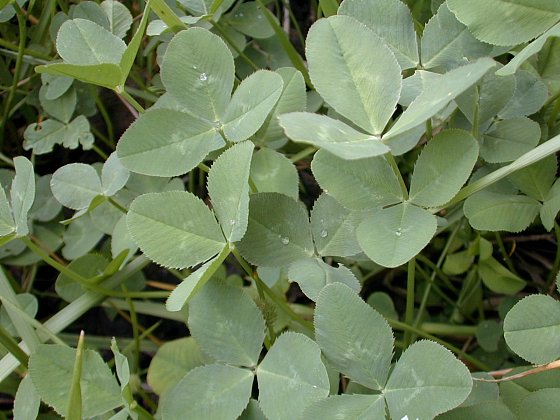
Lucky you — clovers are actually edible. And they're found merely about everywhere there's an open grassy area. You tin can spot them by their distinctive trefoil leaflets. Y'all tin eat clovers raw, but they taste better boiled.
Chicory(Cichorium intybus)

You'll find chicory growing in Europe, North America, and Australia. It'south a bushy plant with small blueish, lavander, and white flowers. You can eat the entire constitute. Pluck off the young leaves and eat them raw or boil them. The chicory's roots will become tasty after humid. And you tin can pop the flowers in your oral cavity for a quick snack.
Chickweed (Stellaria media)

You'll find this herb in temperate and arctic zones. The leaves are pretty hefty, and you lot'll often find pocket-size white flowers on the plant. They usually appear betwixt May and July. Yous can eat the leaves raw or boiled. They're high in vitamins and minerals.
Curled Dock (Rumex crispus)

Yous tin detect curled dock in Europe, North America, South America, and Australia. Information technology's distinguished past a long, vivid red stalk that can reach heights of three feet. Y'all can consume the stem raw or boiled. Merely skin off the outer layers start. It'southward recommend that y'all boil the leaves with several changes of water in lodge to remove its naturally bitter gustatory modality.
Dandelion(Taraxacum officinale)

Sure, information technology'due south an obnoxious weed on your perfectly mowed lawn, merely when you're out in the wild this picayune plant can save your life. The entire plant is edible — roots, leaves, and flower. Eat the leaves while they're still young; mature leaves gustatory modality bitter. If you lot do determine to eat the mature leaves, boil them first to remove their biting sense of taste. Boil the roots before eating too. You can beverage the water y'all boiled the roots in as a tea and apply the flower as a garnish for your dandelion salad.
Field Pennycress (Thalspi vulgaris)
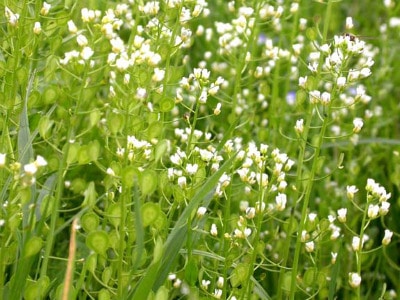
Field pennycress is a weed found in well-nigh parts of the globe. Its growing season is early bound to late winter. Yous tin eat the seeds and leaves of field pennycress raw or boiled. The only caveat with field pennycress is not to consume information technology if information technology'southward growing in contaminated soil. Pennycress is a hyperaccumulator of minerals, meaning it sucks up any and all minerals around it. General rule is don't eat pennycress if it'south growing by the side of the road or is well-nigh a Superfund site.
Fireweed (Epilobium angustifolium)

This pretty little plant is constitute primarily in the Northern Hemisphere. You tin identify fireweed by its purple flower and the unique structure of the leaves' veins; the veins are circular rather than terminating on the edges of the leaves. Several Native American tribes included fireweed in their diet. Information technology'due south best eaten young when the leaves are tender. Mature fireweed plants have tough and bitter tasting leaves. You lot can eat the stalk of the plant as well. The flowers and seeds accept a fiery gustatory modality. Fireweed is a nifty source of vitamins A and C.
Green Seaweed (Ulva lactuca)

If y'all're ever shipwrecked on a deserted island, fish the waters near the beach for some greenish seaweed. This stuff is found in oceans all over the globe. Afterwards you pull dark-green seaweed from the water, rinse with fresh water if available and let it dry. You can consume information technology raw or include it in a soup. Or if y'all're specially enterprising, catch a fish with your bootleg spear and employ the seaweed to make sushi rolls, sans rice.
Kelp (Alaria esculenta)

Kelp is another class of seaweed. You lot can find it in virtually parts of the world. Swallow it raw or include it in a soup. Kelp is a groovy source of folate, vitamin K, and lignans.
Plantain (Plantago)
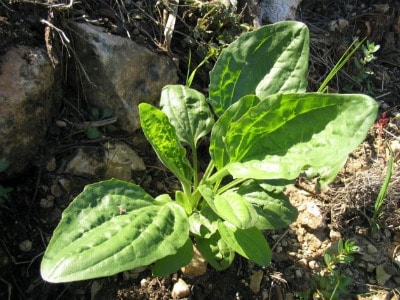
Found in all parts of the world, the plantain plant (not to be confused with the banana-similar plantain) has been used for millennia by humans as a food and herbal remedy for all sorts of maladies. You can usually notice plantains in wet areas similar marshes and bogs, only they'll also sprout upwards in tall areas. The oval, ribbed, short-stemmed leaves tend to hug the ground. The leaves may grow upwards to about vi″ long and 4″ wide. It's all-time to eat the leaves when they're immature. Similar most plants, the leaves tend to get biting tasting as they mature. Plantain is very high in vitamin A and calcium. It too provides a scrap of vitamin C.
Prickly Pear Cactus (Opuntia)
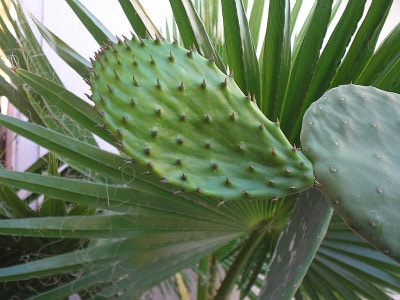
Plant in the deserts of North America, the prickly pear cactus is a very tasty and nutritional plant that can help you lot survive the next time y'all're stranded in the desert. The fruit of the prickly pear cactus looks like a red or purplish pear. Hence the name. Before eating the plant, carefully remove the minor spines on the outer skin or else it will feel like y'all're swallowing a porcupine. You can likewise consume the young stem of the prickly pear cactus. Information technology's best to boil the stems before eating.
Purslane(Portulaca oleracea)
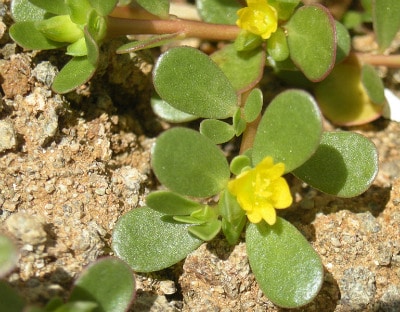
While considered an obnoxious weed in the Us, purslane can provide much needed vitamins and minerals in a wilderness survival state of affairs. Ghandi actually numbered purslane among his favorite foods. Information technology's a small constitute with smooth fat leaves that have a refreshingly sour sense of taste. Purslane grows from the beginning of summer to the commencement of fall. Yous can eat purslane raw or boiled. If you'd like to remove the sour taste, boil the leaves before eating.
Sheep Sorrel(Rumex acetosella)

Sheep sorrel is native to Europe and Asia just has been naturalized in North America. It'south a common weed in fields, grasslands, and woodlands. Information technology flourishes in highly acidic soil. Sheep sorrel has a tall, reddish stem and can reach heights of 18 inches. Sheep sorrel contains oxalates and shouldn't be eaten in large quantities. You can eat the leaves raw. They have a nice tart, most lemony flavor.
White Mustard (Synapsis alba)
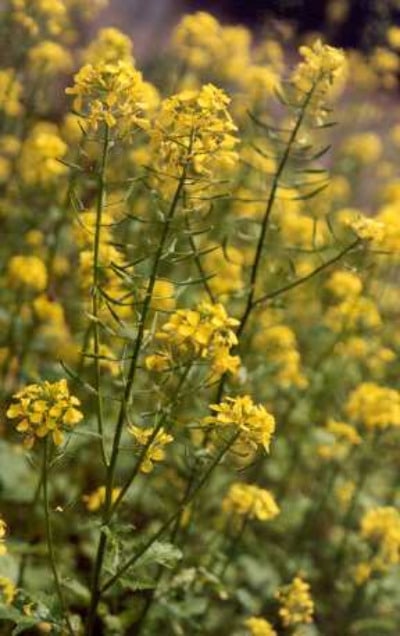
White mustard is institute in the wild in many parts of the world. Information technology blooms between February and March. You tin swallow all parts of the establish — seeds, flowers, and leaves.
Wood Sorrel (Oxalis)

You'll find wood sorrel in all parts of the earth; species variety is peculiarly rich in Southward America. Humans have used wood sorrel for nutrient and medicine for millennia. The Kiowa Indians chewed on wood sorrel to alleviate thirst, and the Cherokee ate the found to cure mouth sores. The leaves are a great source of vitamin C. The roots of the woods sorrel can be boiled. They're starchy and taste a flake like a potato.
Previous Side by side
robinsonwirave1956.blogspot.com
Source: https://www.artofmanliness.com/skills/outdoor-survival/surviving-in-the-wild-19-common-edible-plants/
إرسال تعليق for "Its Ok if All You Did Today Was Survive Art"